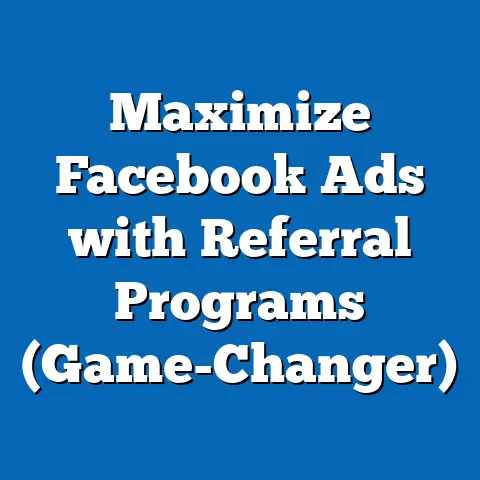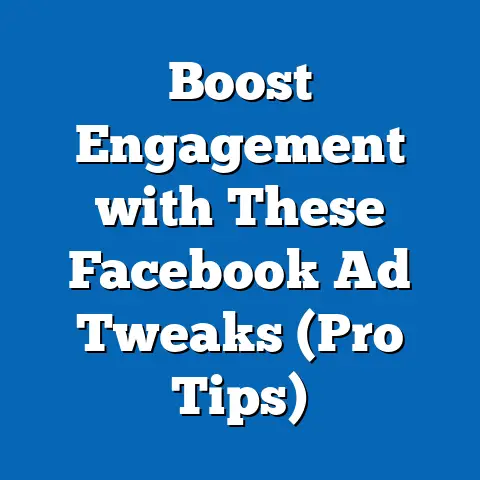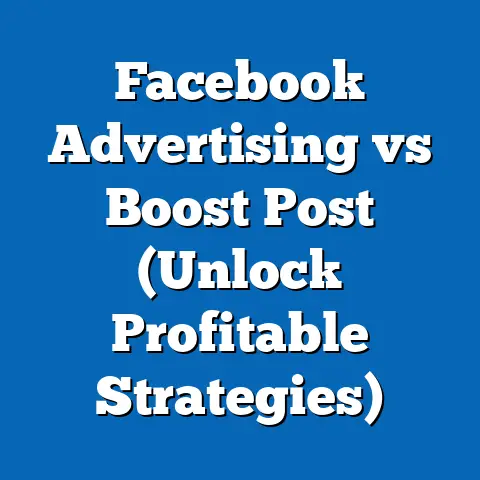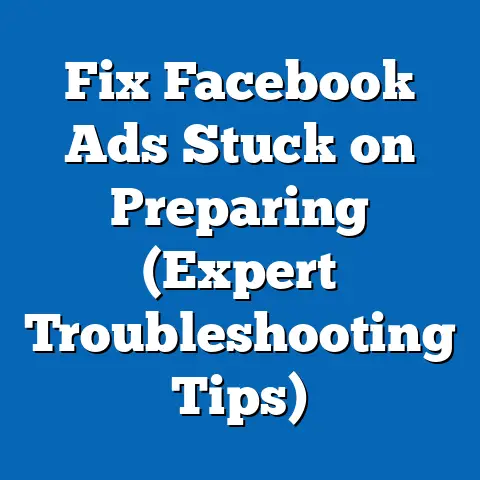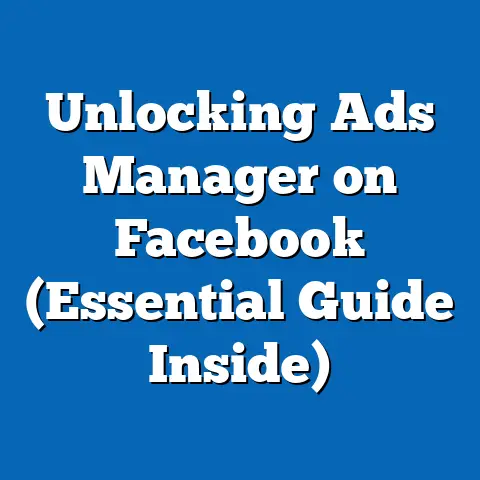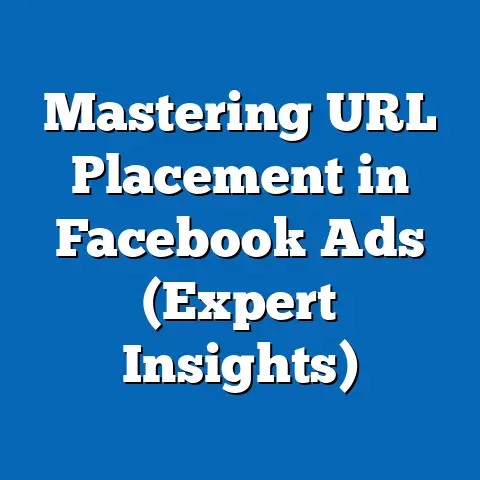Unlock Six-Figure Funnels in Facebook Ads (Proven Strategies)
I’ve always admired the artistry that goes into crafting a truly effective Facebook Ads campaign. It’s not just about throwing money at the platform and hoping for the best. It’s about understanding the nuances of human behavior, the psychology of persuasion, and the ever-evolving landscape of the digital world. Think of it like a master craftsman meticulously honing their skills, carefully selecting their materials, and painstakingly shaping their creation until it’s a work of art. That’s the mindset we need to approach Facebook Ads with if we want to achieve truly transformative results.
Understanding the Facebook Ads Ecosystem
Before we start building our six-figure masterpiece, it’s crucial to understand the foundational elements of the Facebook Ads ecosystem. Think of this as learning the basic tools and materials of our craft. Without a solid grasp of these fundamentals, even the most brilliant strategies will fall flat.
The Core Components
The Facebook Ads platform is a complex beast, but at its heart, it’s built on a few key components:
- Campaign Structure: This includes your Campaign, Ad Set, and Ads. The Campaign defines your overall objective (e.g., conversions, traffic), the Ad Set determines your audience, budget, and placements, and the Ads are the actual creative content your audience sees. Understanding this hierarchy is crucial for effective organization and optimization.
- Targeting Options: Facebook’s targeting capabilities are incredibly powerful. You can target users based on demographics (age, gender, location), interests (hobbies, pages they like), behaviors (purchase history, device usage), and connections (friends of people who like your page).
- Ad Placements: Where your ads appear is just as important as who sees them. Facebook offers a variety of placements, including Facebook Feed, Instagram Feed, Audience Network, Messenger, and more. Each placement has its own unique characteristics and audience expectations.
- The Facebook Pixel: This is a small piece of code you install on your website that tracks user actions. It’s the lifeblood of conversion optimization. The Pixel allows you to track conversions, build custom audiences, and optimize your ads for specific outcomes. Without it, you’re essentially flying blind.
Personal Insight: I remember when I first started using Facebook Ads, I completely underestimated the importance of the Pixel. I was running ads and getting clicks, but I had no idea which ads were actually leading to sales. Once I installed the Pixel and started tracking conversions, it was like a lightbulb went off. I could finally see what was working and what wasn’t, and I was able to dramatically improve my ROI.
Audience Segmentation: Know Your Customer
Understanding your customer is paramount. You can’t create a compelling ad if you don’t know who you’re talking to. This is where audience segmentation and customer personas come into play.
- Audience Segmentation: Dividing your target market into smaller, more homogenous groups based on shared characteristics. This allows you to tailor your ads to specific needs and interests.
- Customer Personas: Creating fictional representations of your ideal customers. These personas should include details like demographics, interests, pain points, and motivations.
Example: Let’s say you’re selling organic skincare products. You might segment your audience into:
- Eco-conscious Millennials: Interested in sustainability and ethical sourcing.
- Busy Moms: Looking for quick and easy skincare solutions.
- Mature Women: Concerned about aging and wrinkles.
For each segment, you would create a specific customer persona with detailed information about their lifestyle, skincare concerns, and purchasing habits.
Data Analytics: Let the Data Guide You
Facebook Ads Manager provides a wealth of data about your campaigns. It’s crucial to leverage this data to inform your ad strategies and optimize your campaigns for better performance.
- Key Metrics: Pay attention to metrics like impressions, reach, clicks, click-through rate (CTR), cost per click (CPC), cost per conversion (CPC), and conversion rate.
- A/B Testing: Experiment with different ad creatives, targeting options, and placements to see what works best.
- Attribution Modeling: Understand how different touchpoints contribute to conversions.
Takeaway: The Facebook Ads ecosystem is a complex but powerful tool. By understanding its core components, segmenting your audience, and leveraging data analytics, you can lay the foundation for a successful six-figure funnel.
Next Steps:
- Familiarize yourself with the Facebook Ads Manager interface.
- Install the Facebook Pixel on your website.
- Start creating detailed customer personas for your target market.
The Anatomy of a Six-Figure Funnel
Now that we have a solid understanding of the Facebook Ads ecosystem, let’s dissect the anatomy of a six-figure funnel. This is where we start to build the framework for our masterpiece.
The AIDA Model
The AIDA model (Awareness, Interest, Decision, Action) is a classic marketing framework that provides a useful structure for building your Facebook Ads funnel. Each stage represents a different step in the customer journey, and each requires a different type of ad creative and messaging.
- Awareness: The goal of this stage is to make your target audience aware of your brand and your product or service. This can be achieved through broad targeting and engaging ad creatives.
- Interest: Once you’ve captured their attention, you need to pique their interest. This can be done by highlighting the benefits of your product or service and providing valuable content.
- Decision: In this stage, you need to convince your audience that your product or service is the best solution to their problem. This can be achieved through testimonials, case studies, and special offers.
- Action: The final stage is to prompt your audience to take action and make a purchase. This can be done through clear and compelling calls-to-action.
Optimizing Each Stage for Higher Conversion Rates
Each stage of the funnel requires a different approach to optimization.
- Awareness: Focus on reach and frequency. Make sure your ads are seen by a large number of people multiple times.
- Interest: Focus on engagement. Encourage users to like, comment, and share your ads.
- Decision: Focus on conversions. Optimize your ads for specific actions, such as signing up for a free trial or requesting a quote.
- Action: Focus on sales. Make it as easy as possible for users to make a purchase.
Case Study: I once worked with a client who was struggling to generate leads for their online coaching program. They were running ads that focused solely on the benefits of the program, but they weren’t seeing any results. After analyzing their data, I realized that they were skipping the Awareness and Interest stages. People didn’t know who they were or why they should care.
We revamped their funnel to include ads that introduced the coach and provided valuable content related to their niche. We then retargeted those who engaged with the content with ads that highlighted the benefits of the program. The result was a dramatic increase in leads and sales.
Hypothetical Example: Let’s say you’re selling a new fitness app.
- Awareness: Run ads that show people using the app in various settings. Use broad targeting to reach a large audience of fitness enthusiasts.
- Interest: Retarget those who clicked on your awareness ads with ads that highlight the key features of the app and provide valuable fitness tips.
- Decision: Retarget those who engaged with your interest ads with testimonials from satisfied users and a special offer for a free trial.
- Action: Retarget those who signed up for the free trial with ads that encourage them to upgrade to the paid version.
Takeaway: The AIDA model provides a useful framework for building your Facebook Ads funnel. By understanding each stage of the customer journey and optimizing your ads accordingly, you can significantly increase your conversion rates.
Next Steps:
- Map out your own Facebook Ads funnel using the AIDA model.
- Identify the key objectives for each stage of your funnel.
- Start brainstorming ad creatives and messaging for each stage.
Proven Strategies for Building Your Facebook Ads Funnel
Now comes the exciting part: building your six-figure funnel! This section will delve into proven strategies for crafting compelling ad creatives, targeting the right audience, and optimizing landing pages for conversions. Think of this as learning the specific techniques and skills required to bring your masterpiece to life.
3.1 Crafting Compelling Ad Creatives
Your ad creative is the first thing your audience will see, so it’s crucial to make a strong impression. This includes both the visual and textual elements of your ad.
The Importance of Visuals
In a visually-driven world, your ad’s image or video is often the deciding factor in whether someone stops scrolling and pays attention.
- Eye-Catching Graphics: Use high-quality images or videos that are relevant to your product or service and visually appealing to your target audience.
- Brand Consistency: Maintain a consistent brand identity across all of your ad creatives.
- Mobile Optimization: Make sure your visuals look good on mobile devices.
Personal Experience: I’ve seen countless ads with blurry, low-resolution images. It’s a huge turnoff! Investing in professional-quality visuals is always worth it.
Persuasive Copy
Your ad copy should be clear, concise, and persuasive. It should highlight the benefits of your product or service and address the pain points of your target audience.
- Headline: Your headline is the first thing people will read, so make it count. Use strong verbs and compelling language.
- Body Text: Keep your body text short and to the point. Focus on the key benefits of your product or service.
- Social Proof: Include testimonials or reviews to build trust and credibility.
Effective Calls-to-Action
Your call-to-action (CTA) is the final nudge that prompts your audience to take action.
- Clarity: Make it clear what you want people to do.
- Urgency: Create a sense of urgency to encourage immediate action.
- Relevance: Tailor your CTA to the specific stage of the funnel.
Examples of Successful Ad Creatives:
- Dollar Shave Club: Their humorous and relatable videos went viral, driving massive brand awareness and sales.
- Airbnb: Their high-quality images of unique accommodations inspire wanderlust and encourage bookings.
- HubSpot: Their valuable content offers (e.g., ebooks, webinars) attract leads and nurture them through the sales funnel.
Takeaway: Your ad creative is your first impression. Make it count by using eye-catching visuals, persuasive copy, and effective calls-to-action.
Next Steps:
- Brainstorm visual concepts for your ad creatives.
- Write compelling headlines and body text that highlight the benefits of your product or service.
- Craft clear and concise calls-to-action that prompt your audience to take action.
3.2 Targeting the Right Audience
Targeting the right audience is essential for maximizing the ROI of your Facebook Ads campaigns. Without effective targeting, you’re essentially throwing money at the wall and hoping something sticks.
Advanced Targeting Strategies
Facebook offers a variety of advanced targeting strategies that can help you reach your ideal customers.
- Lookalike Audiences: Create audiences that are similar to your existing customers. This is a great way to expand your reach and find new customers who are likely to be interested in your product or service.
- Custom Audiences: Upload your own customer data (e.g., email addresses, phone numbers) to create highly targeted audiences. This is a great way to retarget existing customers or reach potential customers who have already interacted with your brand.
- Website Visitors: Target people who have visited your website. This is a great way to retarget people who have shown interest in your product or service but haven’t yet made a purchase.
- Engagement Audiences: Target people who have engaged with your Facebook page or Instagram profile. This is a great way to reach people who are already familiar with your brand.
Retargeting: Don’t Let Leads Slip Away
Retargeting is a powerful strategy for reaching people who have already interacted with your brand. It’s like giving them a gentle nudge to remind them of your product or service.
- Website Retargeting: Show ads to people who have visited specific pages on your website.
- Video Retargeting: Show ads to people who have watched a certain percentage of your videos.
- Lead Form Retargeting: Show ads to people who have started filling out a lead form but haven’t completed it.
Leveraging Facebook’s Audience Insights Tool
Facebook’s Audience Insights tool provides valuable data about your target audience, including their demographics, interests, and behaviors. This information can help you refine your targeting and create more effective ad creatives.
Personal Experience: I’ve used Audience Insights to discover hidden interests and behaviors that I never would have thought of on my own. It’s a goldmine of information!
Takeaway: Targeting the right audience is essential for maximizing the ROI of your Facebook Ads campaigns. Use advanced targeting strategies, retargeting, and Facebook’s Audience Insights tool to reach your ideal customers.
Next Steps:
- Create lookalike audiences based on your existing customers.
- Upload your customer data to create custom audiences.
- Set up retargeting campaigns for website visitors, video viewers, and lead form abandoners.
- Explore Facebook’s Audience Insights tool to learn more about your target audience.
3.3 Optimizing Landing Pages for Conversions
Your landing page is where the magic happens. It’s where your audience will ultimately decide whether or not to take action. If your landing page isn’t optimized for conversions, you’re essentially wasting your ad spend.
The Critical Role of Landing Pages
Your landing page should be a seamless extension of your ad creative. It should provide a clear and compelling offer and make it easy for your audience to take action.
- Relevance: Make sure your landing page is relevant to your ad creative.
- Clarity: Make your offer clear and easy to understand.
- Simplicity: Keep your landing page simple and uncluttered.
- Trust: Build trust by including testimonials, reviews, and security badges.
Best Practices for High-Converting Landing Pages
- Compelling Headline: Your headline should grab attention and clearly communicate the value of your offer.
- Engaging Copy: Your copy should be persuasive and highlight the benefits of your offer.
- Strong Visuals: Use high-quality images or videos that are relevant to your offer.
- Clear Call-to-Action: Make it clear what you want people to do.
- Mobile Optimization: Make sure your landing page looks good on mobile devices.
- Fast Load Speed: Optimize your landing page for fast load speed.
A/B Testing Techniques
A/B testing is a powerful technique for optimizing your landing pages for conversions. It involves creating two versions of your landing page (A and B) and testing them against each other to see which one performs better.
- Test One Element at a Time: Focus on testing one element at a time, such as the headline, the image, or the CTA.
- Use a Reliable A/B Testing Tool: There are many A/B testing tools available, such as Google Optimize, Optimizely, and VWO.
- Track Your Results: Carefully track your results to see which version of your landing page performs better.
Personal Experience: I once ran an A/B test on a landing page for a client’s online course. We tested two different headlines, and the winning headline increased conversions by 20%!
Takeaway: Your landing page is where the magic happens. Optimize it for conversions by creating a relevant, clear, and simple experience that builds trust and makes it easy for your audience to take action.
Next Steps:
- Analyze your existing landing pages to identify areas for improvement.
- Implement best practices for high-converting landing pages.
- Start A/B testing different elements of your landing pages.
Measuring Success and Scaling Your Funnel
Congratulations! You’ve built your Facebook Ads funnel. But the work doesn’t stop there. It’s crucial to measure your success and scale your funnel to achieve your six-figure goals.
Key Performance Indicators (KPIs)
Tracking the right KPIs is essential for understanding the performance of your Facebook Ads campaigns.
- Reach: The number of unique people who saw your ads.
- Impressions: The number of times your ads were displayed.
- Click-Through Rate (CTR): The percentage of people who clicked on your ads.
- Cost Per Click (CPC): The average cost of each click on your ads.
- Conversion Rate: The percentage of people who took the desired action (e.g., making a purchase).
- Cost Per Conversion (CPA): The average cost of each conversion.
- Return on Ad Spend (ROAS): The amount of revenue generated for every dollar spent on ads.
Utilizing Facebook Analytics and Other Tools
Facebook Analytics provides a wealth of data about your audience and their interactions with your website and app. You can also use other tools, such as Google Analytics, to track your website traffic and conversions.
ROI, Customer Acquisition Cost (CAC), and Lifetime Value (LTV)
Understanding your ROI, CAC, and LTV is crucial for making informed decisions about your advertising spend.
- ROI (Return on Investment): The overall profitability of your Facebook Ads campaigns.
- CAC (Customer Acquisition Cost): The cost of acquiring a new customer through Facebook Ads.
- LTV (Lifetime Value): The total revenue you expect to generate from a customer over their lifetime.
Strategies for Scaling Successful Campaigns
Once you’ve identified successful campaigns, you can scale them by:
- Increasing Your Budget: Gradually increase your budget to reach a larger audience.
- Expanding Your Audience Reach: Target new audiences that are similar to your existing customers.
- Optimizing Ad Spend: Continuously optimize your ad creatives, targeting options, and landing pages to improve your ROI.
Personal Insight: I’ve found that the key to scaling successful campaigns is to be patient and data-driven. Don’t make sudden changes to your budget or targeting. Instead, gradually increase your spend and monitor your results closely.
Takeaway: Measuring your success and scaling your funnel is essential for achieving your six-figure goals. Track the right KPIs, utilize Facebook Analytics and other tools, and understand your ROI, CAC, and LTV.
Next Steps:
- Set up tracking for your key performance indicators.
- Analyze your data to identify areas for improvement.
- Start experimenting with different scaling strategies.
Conclusion
Crafting effective Facebook Ads funnels is an art form. It requires a deep understanding of the platform, a keen eye for detail, and a willingness to experiment and adapt. It’s about approaching your campaigns with the mindset of a master craftsman, meticulously honing your skills and carefully selecting your materials until you create a masterpiece.
I hope that the insights and strategies shared in this article have inspired you to take your Facebook Ads campaigns to the next level. Remember to embrace continuous learning, experimentation, and adaptation in your advertising efforts. Take the knowledge you’ve gained and apply it to your own campaigns.
The potential for six-figure success is within your reach. So, go out there and start crafting your masterpiece! I truly believe that with the right knowledge, dedication, and a little bit of artistry, you can unlock the full potential of Facebook Ads and achieve your business goals. Good luck, and happy crafting!

